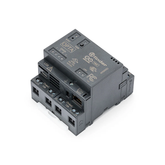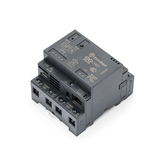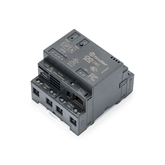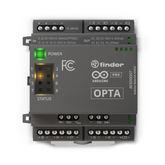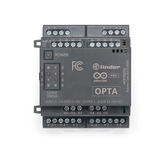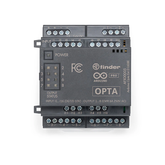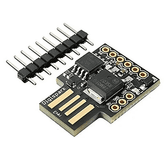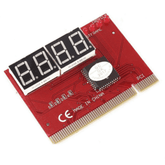What is Arduino Opta? Best Industrial-Grade Micro PLC
Summary
For years, clear line separated hobbyist electronics from the rugged world of industrial automation.
One side was about creativity and rapid prototyping, while the other was about reliability and deterministic control.
The Arduino Opta aims to erase that line, offering a powerful, accessible, and industrial-grade micro-PLC that brings professional automation capabilities to a much wider audience, from seasoned engineers to ambitious makers.

What is Arduino Opta?
To understand the Arduino Opta, we first need to understand what a PLC, or Programmable Logic Controller, does. Think of a PLC as the dedicated, robust brain of an industrial machine.
It reads information from sensors, like temperature probes or push buttons, and makes decisions based on a pre-programmed set of rules to control actuators, like motors, valves, and lights.
They are the unseen workhorses behind everything from factory assembly lines to automated car washes. The Arduino Opta is Arduino's first foray into this field, designed in collaboration with Finder, a renowned European manufacturer of industrial components.
This partnership combines Arduino's user-friendly ecosystem with Finder's decades of experience in building reliable hardware.
It is a "micro-PLC," which means it is a compact, yet powerful device designed for smaller-scale automation tasks.
Unlike a standard Arduino board, which is excellent for prototyping but not typically built for harsh industrial environments, the Arduino Opta PLC is engineered for durability, 24/7 operation, and the precise, real-time control that industrial applications demand.
It bridges the gap for small business owners wanting to automate a process, educators teaching industrial concepts, or makers who want to build projects with professional-grade robustness.
This Arduino PLC is not just another development board; it is a complete control solution.
Key Features of Arduino Opta
The Arduino Opta packs a suite of features that make it a compelling choice for a variety of applications. It is not just about bringing the Arduino name to a new product category; it is about thoughtfully combining the best of two worlds.
- Industrial-Grade Reliability: Engineered by Finder, the Opta is designed to withstand the electrical noise and demanding conditions of an industrial setting. It is built for long-term, continuous operation, providing the peace of mind needed for critical automation tasks.
- Powerful Real-Time Performance: At its heart is a powerful dual-core processor that allows for real-time operations. This means the PLC can react to inputs and control outputs with deterministic timing, a non-negotiable requirement for synchronizing machinery or managing fast-paced processes.
- Dual Programming Environments: This is perhaps its most significant feature. Users can program the device using the familiar Arduino sketch environment (C++) or with standard IEC 61131-3 languages like Ladder Logic via the Arduino PLC IDE. This flexibility welcomes both software developers and traditional automation technicians.
- Integrated Secure Connectivity: The device comes equipped with multiple connectivity options, including Ethernet and, on certain models, Wi-Fi, Bluetooth Low Energy, and RS-485. An onboard secure element ensures that data transmission is encrypted and allows for secure over-the-air firmware updates, making it a perfect industrial micro-PLC Arduino for IIoT (Industrial Internet of Things) projects.
- Open and Extensible Ecosystem: As part of the Arduino Pro family, the Opta is designed to be expandable. It features an expansion port for connecting additional modules, ensuring the platform can grow with the complexity of your project.
Hardware Specifications of Arduino Opta
The hardware specifications reveal a device that is both powerful and practical for industrial deployment. Every component is chosen to deliver performance and reliability in a compact, easy-to-integrate package.
- Processor: The device is powered by an STM32H747XI dual-core microcontroller. It features a high-performance Cortex-M7 core running at up to 480 MHz and a Cortex-M4 core running at up to 240 MHz. This dual-core architecture allows one core to manage real-time control logic and I/O while the other handles more complex applications, communication, and user interface tasks.
- Inputs and Outputs (I/O): It includes eight configurable inputs that can be used as either digital inputs or analog inputs (0-10V). This allows it to connect to a wide range of industrial sensors. For outputs, it provides four high-power electromechanical relays, capable of switching loads up to 10A at 250 VAC, suitable for directly controlling motors, lights, or solenoids.
- Connectivity: All versions include a 10/100 Ethernet port (RJ45) for wired network communication and a USB-C port for programming and power. Specific models add RS-485 half-duplex connectivity for robust industrial bus communication (like Modbus RTU) and Wi-Fi/Bluetooth Low Energy for wireless applications.
- Power and Form Factor: The Arduino Opta operates on a standard industrial power supply of 12-24 V DC. It is housed in a compact enclosure designed to be mounted on a standard DIN rail, which is the universal mounting system used inside industrial control panels and cabinets.
- Security: An integrated ATECC608A/B secure element provides hardware-based security for cryptographic operations, secure boot, and encrypted data storage, a critical feature for connected industrial devices.
Software and Programming Options
The true advantage of the Arduino Opta lies in its software flexibility, which lowers the barrier to entry for industrial programming without sacrificing power. It caters to two very different, yet equally important, developer profiles.
- Arduino IDE and Sketch: For the millions of users familiar with the Arduino ecosystem, the device can be programmed using the Arduino IDE 2.0. You can write code in C++ using the familiar setup () and loop () structure. This approach is ideal for developers with a software background, those transitioning from maker projects, or anyone who prefers the text-based flexibility of a high-level language to create complex logic and algorithms.
- Arduino PLC IDE: For traditional automation engineers and electricians, the Arduino PLC IDE offers a fully compliant IEC 61131-3 programming environment. This standard defines five distinct programming languages; each suited for different tasks:
- Ladder Diagram (LD): A graphical language that resembles electrical relay logic schematics, making it intuitive for electricians and technicians.
- Function Block Diagram (FBD): A graphical language where users connect pre-made function blocks to create logic, ideal for process control.
- Structured Text (ST): A high-level, text-based language similar to Pascal, used for complex algorithms and mathematical operations.
- Sequential Function Chart (SFC): A graphical method for structuring a program into steps and transitions, perfect for sequential machine operations.
- Instruction List (IL): A low-level, text-based language similar to assembly.
This dual-IDE approach means you are not forced into a new paradigm. You can choose the tool that best fits your skills and the project's requirements, a rare feature in the world of PLCs.
Expansion Modules and Accessories
To further enhance its capabilities, the Opta features a dedicated auxiliary expansion port. This allows you to connect a range of official expansion modules, significantly increasing the I/O capacity of your system. These modules connect seamlessly to the base unit, turning the Opta into an even more versatile controller.
- Opta Ext A0602: This Opta Ext A0602 is a powerful analog expansion module. It adds 6 configurable analog inputs that can read signals from a variety of sensors, including voltage, current, and PT100/PT1000 temperature probes. It also provides 2 analog outputs, capable of generating either voltage or current signals to control devices like variable frequency drives or proportional valves.
- Opta Ext D1608S: For projects requiring more digital I/O, this Opta Ext D1608S module provides 16 additional digital inputs (24 V DC) and 8 solid-state relay outputs. Solid-state relays are ideal for applications that require fast, frequent switching and long operational life, as they have no moving parts.
- Opta Ext D1608E: Similar to the D1608S, this Opta Ext D1608E module adds 16 digital inputs. However, it features 8 electromechanical relay outputs. These relays are well-suited for switching higher current loads and are often preferred for their robustness in handling both AC and DC power for devices like motors, solenoids, and contactors.
Setting Up Your Arduino Opta
Getting started with the Arduino Opta PLC is remarkably straightforward, especially when compared to traditional PLC systems. The process can be broken down into a few simple steps.
- Physical Installation: First, securely mount the device onto a DIN rail inside a control enclosure. Connect a 12-24 V DC power supply to the designated terminals. The clear labeling on the device makes this step easy.
- Wiring Inputs and Outputs: Connect your sensors to the input terminals. For example, a simple push-button switch could be wired between a 24V source and one of the digital inputs. For outputs, you can wire a device like a warning light or a small motor to the relay terminals. Always ensure the load is within the relay's rated capacity (up to 10A at 250 VAC).
- Software Connection: Connect the Opta to your computer using a USB-C cable. This connection provides power for programming and establishes a communication link.
- First Program: Open either the Arduino IDE or the Arduino PLC IDE. Let’s consider a simple "Hello, World!" example for a PLC: making a light turn on when a button is pressed. In the Arduino IDE, you would write a simple sketch that reads the state of the input pin and uses digitalWrite() to control the relay output pin. In the PLC IDE, you could draw a simple ladder logic rung with a normally open contact (representing the button) connected to a coil (representing the relay output).
- Upload and Run: Once your code is written, you can upload it directly to the device. After uploading, disconnect the USB-C cable (if it's being powered by the main DC supply), and your automation program will begin to run.
Projects Using Arduino Opta
The combination of robustness, connectivity, and ease of programming opens the door to a wide range of applications that were previously complex or expensive to implement. This is where the vision of accessible industrial automation using Arduino truly comes to life.
- Small-Scale Machine Control: Imagine automating a custom-built packaging machine. The Arduino Opta can read sensors to detect when a product is in place, control a motor to seal the package, and then advance a conveyor belt. Its real-time performance ensures every step is perfectly synchronized.
- Smart Building and HVAC Management: In a small office or workshop, the Opta can serve as the central controller for lighting, heating, and ventilation. By connecting temperature sensors and motion detectors to its inputs, it can intelligently manage energy usage by turning lights off in empty rooms or adjusting the thermostat based on occupancy.
- Industrial IoT Data Acquisition: A key application for this industrial micro-PLC Arduino is monitoring. You can connect various industrial sensors (measuring pressure, flow, vibration, etc.) and use Opta's Ethernet or Wi-Fi capabilities to send this data to a cloud platform like the Arduino Cloud. This enables predictive maintenance, remote monitoring, and data-driven process optimization.
- Automated Agriculture Systems: For a sophisticated greenhouse, the Opta can manage an entire ecosystem. It can read data from soil moisture sensors to control irrigation pumps, monitor temperature and humidity to operate fans and misters, and control grow lights based on a daily schedule. Its reliability ensures the system runs 24/7 without constant supervision.
Conclusion
The Arduino Opta represents a significant step forward in democratizing industrial technology.
By blending the simplicity and vast community support of the Arduino ecosystem with the robust, reliable engineering of an industrial PLC, it creates a unique and powerful tool.
The Arduino Opta PLC is more than just hardware; it is an enabling platform that empowers engineers, makers, educators, and small businesses to tackle real-world automation challenges with confidence.
Whether you are taking your first steps into industrial automation using Arduino or are a seasoned professional looking for a more flexible and cost-effective controller, the Opta provides a compelling and accessible path to turning your ideas into reliable, automated reality.



